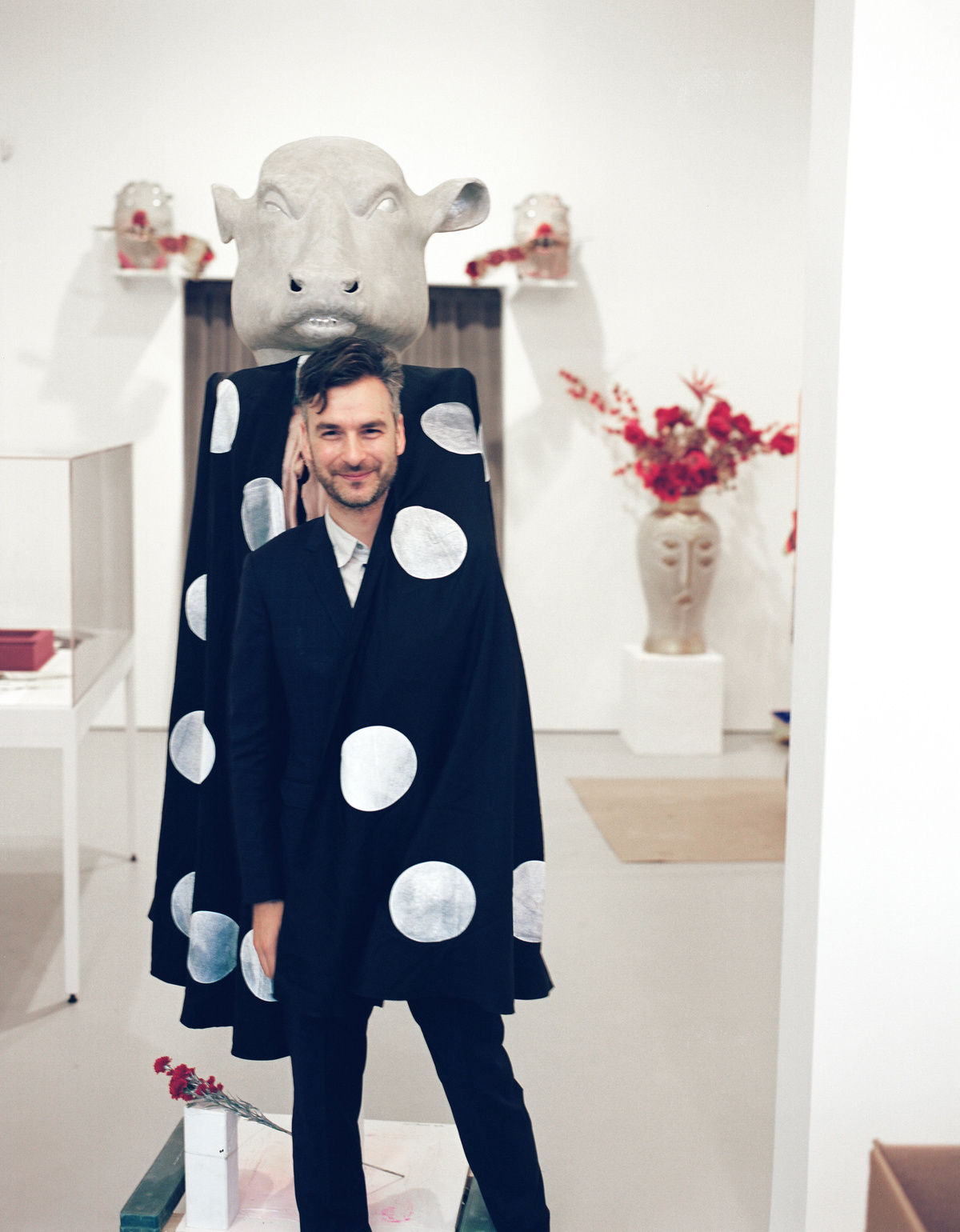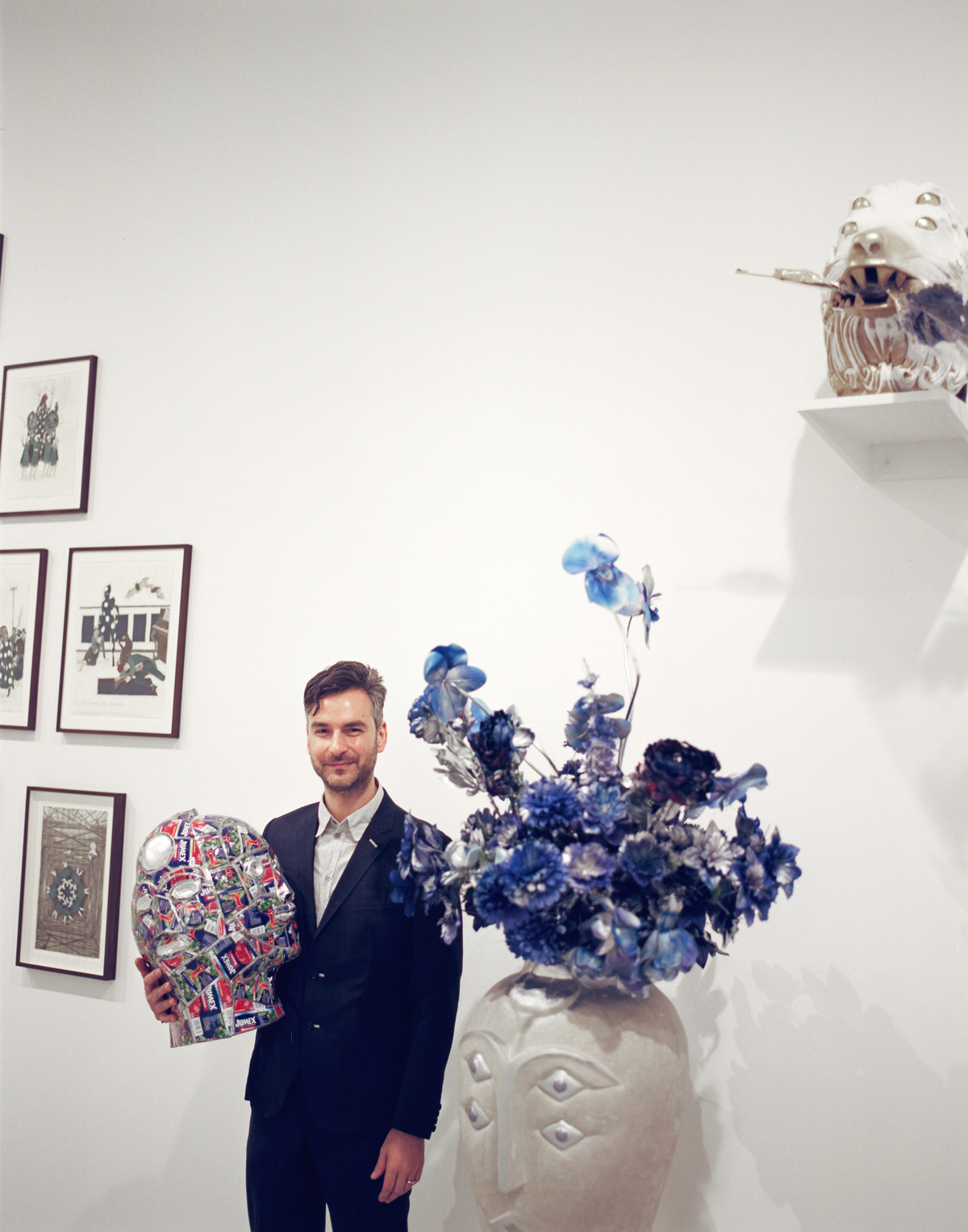With about three hours before his newest solo exhibition opens, we found Canadian artist Marcel Dzama dancing around the David Zwirner Gallery to the thumping drum beat scoring one of his video pieces. The exhibit marks the US premiere of Une Danse des Bouffons (A Jester’s Dance), a film Marcel dubs a “Dadaist love story,” and includes drawings, sculptures, and props from the universe of the film. If this range of media sounds ambitious, remember that Marcel is a multidisciplinary master. Whether it’s puppets, dioramas, Beck’s Guero album cover, art direction of Arcade Fire’s short film The Suburbs, or collaborating with Opening Ceremony, Marcel can do it all. After trying to decide whether to place his giant bull-head sculpture (we temporarily settle on next to the masks he made from Mexican apple juice cans), we spoke to the artist about chess, disco, and Judge Judy.

Can you walk us through the story?
I had this idea of bringing my favorite works of art to life, so I picked a few of them and wrote a whole script around how they could tie in together. It’s basically about Marcel Duchamp’s obsession with playing chess and not making artwork anymore. I had the character of his last major work, Étant donnés, come to life. We kind of based this character on Maria Martins, this artist that he had a love affair with and was obsessed with in real life. So in the film, Duchamp is captured, brainwashed into becoming only a chess player, and eventually becomes this weird chess king. At some point, the trickster comes in and destroys the Duchamp chess player, which she created in the first place because she’s a trickster. It doesn’t make a lot of sense, but in all those mythology stories there’s never really solid reasoning!
How did you go about researching for all of the different works and artists featured?
These are works that I’ve always been obsessed with, so it wasn’t so much research as it was just my response. I first saw Étant donnés in person in 2002 and after that, I just wanted to learn everything about Duchamp’s work! Before that, even as a little kid, I always enjoyed Duchamp because we had the name similarity.
Where did you pull some of these influences from?
In terms of the chess king/judge figure: at the time I was making the film, my wife was pregnant. I was going to doctors’ offices a lot and all of them always had Judge Judy playing, no matter what doctor’s office, always Judge Judy. So I watched a few of those and actually based a scene on Judge Judy.
What motivated your decision to double cast Hannelore Knuts and Kim Gordon for Maria Martens? What do you think each of them brought to the role?
In addition to the film, this exhibition includes drawings that compliment the film and sculptures that were the props we used. The show’s theme comes from a trickster story from Africa where the trickster walked between two farmers wearing a half red, half blue suit, and the farmers went to war over what color their God was. So one side of the show is blue, the other side is red. When I had the two actresses, it sort of made sense that there were these two different versions of each other.
I’ve always had sort of a fascination with Kim Gordon. She brought entirely perfect attitude for the character: this sort of cool, world-weary, she’s got things under control even when they’re totally out of control type of way. Hannelore was interested already, but I’d filled all of the other roles, so I chose her for the trickster as well. I liked the idea that there was interaction in the film between the two of them, so the worlds kind of collide at some point.
If you could write the adventures of any other artist, who would it be?
I kind of put all my favorites in this one: Picabia, Goya… Oh you know what, I never did William Blake! I’d love to do him for something.
Can you tell us a little bit more about the Arcade Fire’s involvement and how that came about?
They were great! Will Butler was mixing Reflektor here in New York and we recorded a couple tracks, so two or three of the songs I actually got to collaborate on. I’ve always kind of wanted to be a musician, so it was very nice to do that. But definitely the better tracks on there aren’t me!
Kim’s not on the soundtrack at all, is she?
No, I got too shy to ask her! Originally we did record a song for her to sing. There was going to be a moment where she’s brought up to the judge and performs a disco song. We recorded the musical track but I just got too shy. I even had lyrics written for it that were kind of maybe too similar to this Leonard Cohen song “The Future.” Maybe it was good it didn’t pan out so I didn’t end up a plagiarist!
Credits
Text Emily Manning
Photography Benedict Brink
